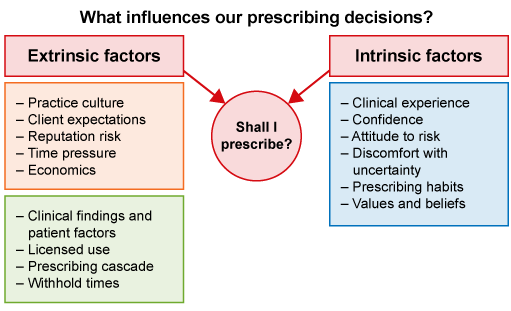3.4 Factors influencing decisions to give antimicrobials animals
While prescribing antimicrobials is relatively straightforward in human health, it can be much more complicated in animal health. Prescribing decisions are influenced by the purpose of use (therapeutic and non-therapeutic) and stakeholder needs such as cost, diagnostic testing, drug withdrawal times and social and cultural expectations.
A common outcome from seeing a veterinarian is the prescribing and dispensing of antimicrobials. There are a range of extrinsic (external) and intrinsic (internal) factors that influence decisions about using antimicrobials (Figure 7).
In countries where veterinarians and veterinary paraprofessionals are scarce, decision making about and responsibility for antimicrobial use often falls back onto farmers. In LMICs, awareness of AMR and AMS in food animals is often limited and decisions to use antimicrobials are usually based on seeking a ‘quick fix’, economics and finances.

Extrinsic factors impacting on prescribing decisions are shown in Figure 7 and in particular include:
- The clinical findings and patient-related factors such as pregnancy status. Knowledge of the bacteria causing the illness and the physiological state of the animal may affect the activity of the antimicrobial.
- The registered uses of an antimicrobial, for example only using an antimicrobial registered to treat foot rot in cattle.
- Off-label use occurs when an antimicrobial is used to treat a condition that it is not registered to treat and/or in a species it is not registered to treat. Off-label use should only be done when there is no other registered alternative, the animal’s health and welfare is compromised, and follow the prescribing cascade.
- For some species, such as goats, there are few antimicrobials registered for use. In this case, off-label use of preparations registered in sheep used in accordance with other label directions is generally considered appropriate.
- The
withholding period (WHP) is a critical consideration in deciding what antimicrobial to use in food animals. The WHP is the time from the last treatment to when the animal can be slaughtered or milked (or eggs consumed), and residues are below the limit of food safety concern.- Long WHPs on some drugs (e.g. long-acting penicillin has a 30-day WHP) are more likely to be used when animals are not going to be slaughtered for a long time. In contrast, antimicrobials with short withhold periods (e.g. short-acting penicillin has a five-day WHP) are more likely to be used close to slaughter.
- When using drugs in an off-label manner, care should be taken to ensure animals are clear of residues before slaughter as the WHP is often extended.
- Client expectations and reputational risk can be critical factors related to why an antimicrobial may be given. Some studies have reported that veterinarians often feel pressured to prescribe antimicrobials and have a ‘just-in-case’ approach, fearing a risk to their business if they don’t meet client expectations.
- There is an economic incentive to prescribing and dispensing antimicrobials, and the income of veterinarians relies to some extent on the sale of drugs. This may influence prescribing decisions.
- In many countries, veterinarians must only prescribe antimicrobials that are registered for use in animals. However, this is not always possible or practical as there are few antimicrobials registered for use in certain animal species (e.g. fish) or for some uses of animals (e.g. dairy sheep). To strike a balance between legal prescribing requirements and the need to treat a wide range of conditions in animals, the laws in these countries permit a veterinarian to exercise their professional judgement to prescribe unregistered or off-label antimicrobials in certain circumstances. This is known as the ‘
prescribing cascade ’.
Intrinsic factors impacting on whether to give an antimicrobial or not are listed in Figure 7 and have a lot to do with behaviour and attitude to risk:
- Clinical experience helps with confidence in decision making, including deciding not to prescribe an antimicrobial. Prescribing can be driven by a lack of experience.
- Prescribing can be driven by the sense of discomfort or uncertainty with clinical evidence.
- Habits can be hard to break. Like doctors, veterinarians develop habits and patterns in prescribing antimicrobials. Another habit, driven in part by accessibility, reliability and economics, is to not request a diagnostic test which would enable an informed prescription.
Activity 8: Impactors on prescribing decisions
3.3 Who is responsible for antimicrobial stewardship?



